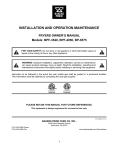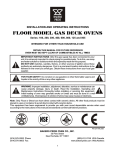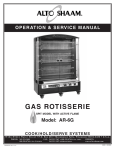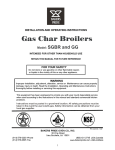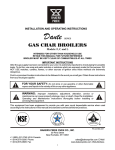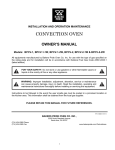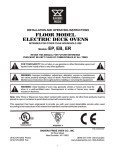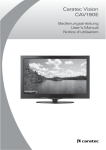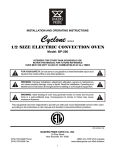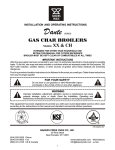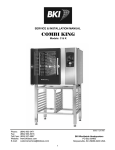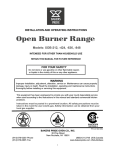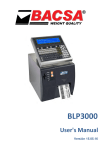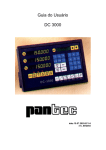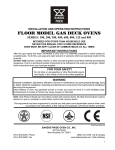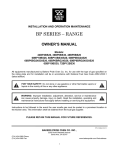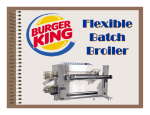Download Bakers Pride FC-816 Operating instructions
Transcript
BAKERS
PRIDE
INSTALLATION AND OPERATING INSTRUCTIONS
IL FORNO CLASSICO OVENS
Series:
FC-516, FC-616 and FC-816
INTENDED FOR OTHER THAN HOUSEHOLD USE
OVEN MUST BE KEPT CLEAR OF COMBUSTIBLES AT ALL TIMES
RETAIN THIS MANUAL FOR FUTURE REFERENCE
IMPORTANT INSTRUCTIONS
After the gas supply has been connected to your unit, it is extremely important to check piping for
possible leaks. To do this, use soap and water solutions, or solutions which are expressly made for this
purpose. DO NOT USE matches, candles, flames, or other sources of ignitions since these methods are
extremely dangerous.
In a prominent location post instructions to be followed in the event you smell gas. Obtain these
instructions from your local gas supplier.
!
For Your Safety: Do not store or use flammable liquids or vapors in the vicinity of this
or any other appliance.
!
!
Warning: Improper installation, adjustment, alteration, service or maintenance can
cause property damage, injury or death. Read the Installation, Operating and
Maintenance instructions thoroughly before installing or servicing this equipment.
Initial heating of oven may generate smoke or fumes and must be done in a well
ventilated area. Overexposure to smoke or fumes may cause nausea or dizziness.
!
NOTE: Only Pizza and Bread Products can have direct contact with Ceramic Decks. All other food products
must be placed in pans or containers to avoid direct contact with Ceramic Decks.
This equipment has been engineered to provide you with year round dependable service when used
according to the instructions in this manual and standard commercial kitchen practices.
IG
DES N
CE
CERTIFIED
R TIFIED R
R
P/N U4116A 9/07
BAKERS PRIDE OVEN CO., INC.
30 Pine Street
New Rochelle, NY 10801
(914) 576-0200 Phone
(914) 576-0605 Fax
(800) 431-2745 US & Canada
www.bakerspride.com Web Address
1
TABLE OF CONTENTS
I.
INSTALLATION INSTRUCTIONS
1. Receiving
2. Clearances
3. Set-up
A. Mounting Legs with Casters
4. Pizza Decks & Optional Ceramic Top
A. Three Deck Installation
B. Four Deck Installation
C. Optional Ceramic Top Installation
5. Booster Burner Installation
6. Gas and Electric Connections
7. Main Burner Safety Pilot Operations
A. Pilot Burner Lighting Procedure
B. Pilot Burner Flame Adjustment
8. Burner Operation
A. Main Burner
B. Booster Burner
C. Aeration & By-Pass Flame Adj.
9. Thermostat Calibration
10. Flame Diverters
II. OPERATING INSTRUCTIONS
3
3
4
5
6
6
6
7
7
7
9
9
10
10
10
10
11
11
11
1.
2.
3.
4.
5.
Lighting Procedures
Breaking-In
Baking
Recommended Operating Procedure
Helpful Hints
11
11
11
12
12
III. CLEANING and MAINTENANCE
1.
2.
3.
4.
5.
Stainless Steel Surfaces
Painted Surfaces
Door Mechanism
Flue Vent
Oven Interior
A. Baking Chamber
B. Bake Decks
C. Burner Compartment
Wiring Diagram
Warranty
12
13
13
13
13
13
13
13
14
15
MODELS COVERED
FC-516 Pizza Oven
FC-616 Pizza Oven
FC-816 Pizza Oven
140,000 BTU/Hr (41 kw)
140,000 BTU/Hr (41 kw)
140,000 BTU/Hr (41 kw)
FOR EUROPEAN COMMUNITY COUNTRIES: 230 VOLTS, 1 PHASE, 50 HZ.
EN 437
Gas Cat.
Gases and Supply
Pressures
I 2H
G20 @ 20mbar
I 2L
G25 @ 25mbar
I 2E
G20 @ 20mbar
I 2E+
G20/25 @ 20/25mbar
Designated European Market =
A B D F F G D I I L N P E S G
T E K I R R E E T U L T S E B
FOR NORTH AMERICA: 120 or 208/240 VOLTS, 1 PHASE, 60 HZ.
Type of Gas
Manifold Pressure
Natural
3.5” Water Column
LP
10” Water Column
2
I. INSTALLATION INSTRUCTIONS
1. RECEIVING:
Read the notice on the outside carton regarding damage in transit. Damage discovered after
opening the crate(s) / carton(s) is “CONCEALED DAMAGE” and the carrier must be notified
immediately to send an inspector and also furnish the forms for the consignee's claim against the
carrier.
When oven arrives, it should consist of : A crate, or carton, containing your new oven, a carton,
containing 4 legs with mounting hardware, and a strapped skid, containing baking decks.
In MASSACHUSETTS: All gas products must be installed by a “Massachusetts” licensed plumber
or gas fitter. Ventilation hoods must be installed in accordance with NFPA-96, current edition, with
interlocks as described in that standard.
Installation must conform with local codes and/or with the latest edition of the ANS Z-233.1 National
Fuel/Gas Code in USA / CAN/CGA-B 149.1 or 2 Installation Code in Canada.
This appliance must be installed by a competent person. In the U.K., Corgi registered Installers
(including the regions of British Gas) undertake to work to safe and satisfactory standards. This
appliance must be installed in accordance with the current Gas Safety (Installation and Use)
Regulations and the relevant Building Regulations / IEE Regulations.
Detailed
recommendations are contained in the British Standard Codes Of Practice BS 6172, BS 5440:Part
2 and BS 6891.
Place the oven and parts as close as possible to the area of final installation before un-crating.
2. CLEARANCES:
Minimum Clearance
From Combustible Construction
Non-Combustible Construction
Left Side
3” (76 mm)
0
Right Side
1” (25 mm)
0
Rear
3(76mm)
2” (51 mm)
Front and Flue Area - Enclose only with non-combustible materials.
Sketch “A”
60°
Louvered Service Panel
Lintel Plate
3/4 NPT
Gas Inlets
115VAC, 15 Amp
NEMA 5-15P
16” (406mm)
Left Side View
3
Sketch “B”
12"
(305mm)
Main Burner
FRONT VIEW
2 1/4
(57mm)
33"
(838mm)
30" STD.
(762mm)
10”
(254mm)
Push-Pull Knobs
Oven Controls
A. Provisions must be made for easy access to the louvered service panel on the left side of the unit.
A removable panel at least 16” x 31” (406 x 787 mm) in line with the service panel to facilitate a
service man to work will be satisfactory. See installation sketch “A”.
B. Reference to back panels deleted. No longer necessary.
C. Easy accessibility through the front of the oven to the main burner, oven controls and flue slide push
/pull knobs must be provided. See installation sketch “B”.
3. SET-UP: The oven must be installed in a well-ventilated area.
Your oven is packed standing on its back. Leave in on it's back while unpacking. The skid may be
left under the oven for convenience in further handling. Unpack carefully to avoid damage to the
oven. If concealed damage is found, follow the instructions detailed in Section 1.
Keep the area around the oven free and clear of combustible materials. Do not store any materials
on top of or under any oven. Provisions for adequate air supply to your oven for ventilation and
proper gas combustion is essential. As a minimum, observe the clearances detailed in Section 2.
Provide adequate ventilation and make up air in accordance with local codes.
The oven must be installed under a ventilation hood. Fit the flue diverter (see Sketch “C”) into the
hole in the top front of the oven and secure with the screws supplied. Local inspectors and
ventilation specialists should be consulted to make sure that the installation of the hood conforms to
the local codes and requirements (see Sketch “D”).
In the U.K., ventilation requirements detailed in BS 5440 should be followed.
Access to the bottom front door and left side control panel is required for day to day operation of the
oven and for servicing. Make sure that these areas are kept unobstructed for easy access.
Sketch “C”
iverter
Flue D
IDE
RS PR
BAKE
4
Sketch “D”
(Not In
d
o
o
Vent H
BAK
PR
ERS
)
cluded
IDE
A. MOUNTING LEGS WITH CASTERS:
Legs are shipped in a separate carton complete with mounting hardware and casters, (two of them
with wheel brakes).
NOTE : Installation should be made with a connector that complies with the latest edition of the
Standard for Connectors for Movable Gas Appliances ANSI Z21.69 in the USA (CAN CGA6.16 in
Canada) and a quick disconnect device that complies with the latest edition of the Standard for
Quick Disconnect Devices for use with gas fuel ANSI Z21.41 in the USA (CAN CGA 1-6.9 in
Canada) and adequate means must be provided to limit the movement of the appliance without
depending on the connector and any quick disconnect device or its associated piping. The restraint
should be attached to the rear legs of the oven on which casters are mounted. If disconnection of
the restraint is necessary to move the oven for servicing needs, the restraint should be reconnected
after the appliance has been returned to its originally installed position.
a) Bolt two (2) legs with casters and wheel brakes firmly to the two (2) upper (front) corners of
the oven as it stands on the skid (see Sketch “E”).
b) Using proper lifting equipment, lower the oven down so that the two bolted legs rest on the
floor (see Sketch “F”).
c) Using proper lifting equipment, raise the back side of the oven to a height slightly higher
than the height of the legs, remove the skid and place a sturdy support under the back side
(see Sketch “G”). Mount remaining two (2) legs and tighten bolts. Lift the oven and remove
the supports.
d) Move the oven to its final location, keeping the minimum clearances from the back of the
oven to the wall. This clearance is necessary for safe operation and to provide proper air
flow to the burner chamber.
5
Sketch “F”
Sketch “G”
BA
KE
RS
PR
ID
E
ERS
BAK
PRID
E
Sketch “E”
B AK
ERS
E
PRID
4. PIZZA DECKS AND OPTIONAL CERAMIC TOP:
a) Remove all packaging material, samples, shims, etc., from the bake chamber, leaving the two
metal hearth liner sheets in place on the bake chamber floor. Make sure that the two metal
hearth liner sheets cover the entire bottom of the chamber.
b) Three (model FC-616) and four (models FC-516 and FC-816) slabs of the Pizza Deck are
provided with the oven. This material is heavy and fragile and should be handled carefully.
NOTE 1: When sliding in the slabs, be very careful not to hit the booster burner
components at the rear of the bake chamber.
NOTE 2: If the side wedge is pushed in too tightly, the heat control slides, operated by the
black knobs located on the front of the oven, will not slide freely.
A. Three Deck Installation: (Model FC-616)
a) Slide one slab into the bake chamber and push it as far as possible to one side.
b) Slide the second slab into the bake chamber on the side opposite to the first slab.
c) Slide the third slab into the center section.
d) Use metal shims as needed to level the slabs.
e) Use two wedges in the back and another on one side of the decks. The three slabs should be
tight against each other with no gap in between them (See Sketch “H”).
Sketch “H”
Wedges
Left Interior Oven Wall
Wedge
e
Thre
Left Deck
D e ck
Front View
B. Four Deck Installation: (Models FC-516 and FC-816)
a) Slide one slab into the bake chamber and push it as far as possible to one side towards the rear.
b) Slide the second slab into the bake chamber and push it next to the first slab in the rear.
c) Slide the third and fourth slabs in front of the slabs already in place.
d) Use metal shims as needed to level the slabs.
e) Use one (FC-516) or two (FC-816) wedges in the back and another on one side of the decks.
The four slabs should be tight against each other with no gap in between them (See Sketch “I”).
6
Sketch “I”
Wedges
Left Interior Oven Wall
Wedge
r De
Fou
ck
Left Deck
Front View
C. Optional Ceramic Top Installation (Refer to “Top Brick Lining”, Page 8):
If the oven was ordered with the ceramic top option, the two top supports are already installed.
Simply slide in the ceramic tops as per instructions below. If this option is an add-on, you must follow
the instructions provided with the Ceramic Top Installation kit.
a) Through the arched front opening, insert one of the center slabs (20 13/16 x 20 13/16 for FC616
and FC816)(17 1/2 x 17 3/4 (left to right) for the FC516) into the bake chamber, raise one side
until the other side comes to rest onto the center support, then lower the first side to lock it in
between the two center supports. Push it to the rear as far as possible to make room for the
second center slab.
b) Install the second center slab (20 13/16 x 20 13/16 for FC816)(14 3/16 x 20 13/16 (left to right)
for FC616)(17 1/2 x 17 3/4 (left to right) for FC516) into the bake chamber and push it tightly
against the first slab.
c) Install the side slabs (20 13/16 x 20 13/16 for FC816)(17 1/2 x 17 3/4 (left to right) for FC616)(17
1/2 x 13 3/4 (left to right) for FC516) in a similar fashion, raising the slab in the center until the
lower side edge rests on the side support, then lowering the upper edge onto the center support.
First the ones in the rear, then the ones in the front, pushing them tightly against the first slabs.
5. BOOSTER BURNER INSTALLATION:
NOTE: The Booster Burner and the Booster Burner Guard are shipped inside the burner
compartment and have to be installed before the booster burner can be used for the first
time.
a) Once the Pizza Deck Slabs are installed as per instructions above, place the booster burner and
guard inside the bake chamber, as far back as possible, then follow with your upper torso and do
the following:
b) Center the guard in front of the booster burner brackets, flange down, wings back, then push it
all the way back and under the booster burner brackets.
c) Reach over the guard, slip the throat of the booster burner over the gas nozzle, then lower it and
insert the two burner ends into the locating slots of the booster burner brackets and push them
all the way down.
6. GAS AND ELECTRIC CONNECTIONS:
NOTE: Propane Gas Units are not available in the European Community.
a) Normal factory connections are made for 120 Volts AC, 60 Hz operation in USA and Canada.
For use in Europe, the connections are made for 230 Volts AC, 50 Hz operation.
b) The appliance, when installed, must be electrically grounded in accordance with local codes
and/or the latest edition of the National Electric Code ANSL/NFPA 70 in USA (Canadian Electric
Code CSA C22.2 in Canada).
7
TOP BRICK LINING LAYOUT
{
Front
View
}
FC-516: 17 3/4”
FC-616: 20 13/16”
FC-816: 20 13/16”
{
}
3/4”
6: 13
FC-5116: 17 3/4””
FC-6 16: 20 3/4
FC-8
{
17 3/4
13 3/4
FC-5
FC-6116: 13 3/4
FC:81 6: 17 3/4 ”
”
6: 20
3/4”
}
13 3/4
37” Overall
17 ½
FC-516
FC-516
Top View
17 ½
17 3/4
13 3/4
2” Spacers In Front
13 3/4
17 3/4
20 13/16
20 13/16
FC-616
Top View
17 ½
37” Overall
17 ½
20 3/4
FC-616
17 ½
17 ½
16 13/16
17 3/4
20 3/4
2” Spacers In Front
20 3/4
20 13/16
20 13/16
20 13/16
FC-816
FC-816
Top View
20 13/16
20 3/4
20 3/4
3 3/8”” Spacers In Front
20 3/4
NOTE: Brick Lining ships separately - Installation by others.
8
37” Overall
20 13/16
c) In Europe, the appliance must be connected by an earthing cable to all other units in the complete
installation and thence to an independent earth connection in compliance with EN 60335-1 and/or
local codes.
d) The hot surface ignition system, all related switches, indicator light and fuse, are all connected
through the 6 ft (1830 mm) power supply cord. The power supply cord must be plugged into a
properly grounded three-prong receptacle.
Do not cut or remove the ground prong from the plug.
e) A wiring diagram may be found behind the service panel on the left side of the unit and also in this
manual.
f) The ovens should not be installed on the same line with space heaters, boilers or other gas
equipment with high intermittent demand.
g) Use a pipe joint compound that is resistant to the action of liquefied petroleum gases when making
gas connections.
h) For Propane gas, use a least ½” pipe or tubing with a 5/8” inside diameter. For Natural gas, use ¾”
pipe.
i) The appliance must be isolated from the gas supply piping system by closing its manual shut-off
valve during any pressure testing of the gas supply piping system at test pressures equal to or less
than ½” psig (3.45 kpa).
j) The appliance and its shut-off valve must be disconnected from the gas supply piping system
during any pressure testing of that system at test pressures in excess of ½” psig (3.45 kpa).
k) The gas pressure regulators are part of the combination valves and are adjusted to yield a pressure
of 3.5” water column (9 mbar) for Natural Gas. If the oven has been ordered for use on Propane
Gas, the pressure regulators in the combination valves are preset at the factor to yield a pressure of
10” water column (25 mbar).
l) A separate shut-off valve for each oven must be provided. It should be as close as possible to the
place where the gas line enters the oven. It must be located where it is easily and quickly
accessible.
m) When stacking with another type of oven, two (2) shut-off valves, one for each of the two ovens,
must be provided.
After the gas supply has been connected, it is extremely important to check all the piping for leaks. Use a
soap and water solution or a product made expressly for this purpose. Do not use matches, candles or a
flame etc. to check leaks since these methods are extremely dangerous.
7. SAFETY PILOT OPERATION:
The purpose of the safety pilot system is to lock the gas supply to the burner at the combination
valve, if for any reason the pilot burner is not lit. The pilot should be re-lighted by following the steps
given below. However, in normal service, the pilot flame stays lit indefinitely, day and night,
including weekends. This prolongs the life of the safety valve.
The safety pilot valve is in effect a two-stage control. After initial lighting, the pilot burner stays on
without the gas cock dial being held pressed in. After 1-2 minutes, the valve opens fully to let the gas
flow past the safety pilot valve and into the burner system.
A. PILOT BURNER LIGHTING PROCEDURE:
a) Partially depress and turn the gas cock dial to the “OFF” position.
b) Wait for five minutes to allow gas, which may have accumulated in the burner compartment, to
escape.
c) Turn gas cock dial to “PILOT” position.
d) Depress gas cock dial.
e) For Main Burner: With a match or igniter light pilot burner. Hold gas cock dial in pressed
position for about 1/2” minute and then release it. The Pilot Burner flame should now remain
lit. If Pilot Burner fails to ignite or does not remain lit, repeat steps (a) thru (e).
f) For Booster Burner: Flip toggle switch to the “ON” (I) position. The amber indicator lamp will
light up and the igniter will be energized and start to glow. Hold gas cock dial in pressed position
for about 2-3 minutes and then release it. The Pilot Burner flame should now remain lit. If Pilot
Burner fails to ignite or does not remain lit, repeat steps (a) thru (d) and (f).
Note: The built-in igniter is for convenience of lighting only and not necessary for the booster
burner operation. In case of power failure, or if the igniter will not light the pilot flame, the pilot
flame can also be lit with a long hand-held igniter or with a long, lit taper.
9
Sketch “K”
Sketch “J”
Pilot
Feed
Correct Flame
IN
FF
OFF
PILOT
PI
ON
T
LO
3/8” - 1/2”
TH
TP
TP
TH
Gas
Cock
Dial
VENT
Pressure
Regulator
0
550
60
0
65
0
50
30
0
0
35
400
45
0
Pilot
Adjust
Screw
Thermostat
B. PILOT BURNER FLAME ADJUSTMENT:
It is important to have the correct Pilot Burner Flame size as shown in (Sketch “J”). If necessary,
adjust the Pilot Burner Flame by turning the Pilot Adjustment Screw (see Sketch “K”) clockwise to
reduce or counter-clockwise to increase.
8. BURNER OPERATION:
A. MAIN BURNER:
After the pilot burner is ignited, when heat is desired, turn gas cock dial to the “ON” position and set
the thermostat dial to the desired temperature. The oven burner flame should always have a blue
appearance. That indicates a good mixture of gas and air. When using LP gas, the flame will have
a blue-yellow appearance.
B. BOOSTER BURNER:
Do not turn on the booster burner until the oven is well pre-heated and the pre-set
temperature has been reached. The oven has to be hot in order to draw fresh air in to the
booster burner.
After the pilot burner is ignited, when the booster burner flame is desired, turn gas cock dial to the
“ON” position. The booster burner is set to have a yellow flickering flame, but should not soot.
10
Should the Burners fail to light, check to see if there is a problem with the gas supply. If there are
other appliances
temporarily
and
seesee
if the
burners
come
backback
on, on,
appliances on
onthe
thesame
sameline,
line,shut
shutthem
themoffoff
temporarily
and
if the
burners
come
or they fluctuate as other gas appliances are turned on and off. That would indicate an overload of
the gas supply lines or a faulty gas pressure regulator. Contact an authorized Service Agency or
your local Gas Supply Company.
C. AERATION and BY-PASS FLAME ADJUSTMENT:
Flame and air mixer adjustments for the Main Burner and the Booster Burner, and the By-Pass
Flame adjustment for the Main Burner are all done at the factory. These adjustments are sealed
before the oven leaves the factory. Contact an authorized Service Agency if you need help.
9. THERMOSTAT CALIBRATION:
No attempt should be made to calibrate the thermostat because it is accurately calibrated and
sealed by the manufacturer. Contact an authorized Service Agency if you need help.
10. FLAME DIVERTERS:
Flame diverters distribute the heat evenly below the baking deck. They must be in good condition
and properly placed above the burners in the burner chamber in order to be effective. Damaged or
improperly installed flame diverters adversely affect the oven performance. Make sure that the "Vshaped” diverters are pushed all the way to the back of the oven as far as they will go. Check them
periodically and replace them as necessary.
II. OPERATING INSTRUCTIONS
If gas odor is detected at any time, immediately shut off the gas supply valve to the oven. Do not permit any
open flames in the area of the oven. Immediately contact an authorized Service Agency or your local
Gas Supply Company.
Initial heating of the oven must be done in a well-ventilated area as it may generate smoke or fumes. Overexposure to smoke or fumes may cause nausea or dizziness.
1. LIGHTING PROCEDURE:
a) Light the Main Burner following the instructions in Section 7A of the Installation Instructions.
b) Keep the Push/Pull Slides fully open.
2. BREAKING IN:
A break-in period, after installing a new oven, is important to allow the deck and the insulation to
dry out. Baking in the oven before a break-in period will result in poor performance. For
breaking in:
o
o
a) Allow the oven to warm to 300 F (150 C) for 5 hours or at least until all the smoke and fumes
have disappeared. The smoke and fumes are from the moisture in the deck and insulation
and a light coat of oil on all of the sheet metal.
o
o
b) Set the thermostat at least 50 F (30 C) lower than your baking temperature.
c) Pre-heat the oven for 1 to 1 ½” hours before use.
d) After this pre-heating, raise the temperature to your baking temperature.
e) Light the Booster Burner following the instructions in Section 7B of the Installation
Instructions.
f) Experiment baking until you get the feel of the oven and the speed of the bake.
3. BAKING:
Pizza can be baked on the deck, on a screen or in a pan. When you determine the combination
of method, ingredients and temperature that gives the right bake for your crust, sauce and
cheese combination and your customer's taste, mark it down and keep it. Consistency is the
key to repeat business.
Deck baking refers to placing the pizza directly on the deck to bake. Generally, it is a thin
o
o
product that requires a high baking temperature of at least 550 F (290 C).
Screen baking refers to placing the pizza on a screen to bake. The screen keeps the pizza off
the deck. The screen may be removed near the end of the bake time to give the bottom of the
11
o
o
o
o
pizza crust a darker color. Bake temperatures range from 500 F (260 C) to 550 F (290 C).
Pan baking refers to pizza when baked in pans. Crust can be thick or thin and toppings range
o
o
o
from light to heavy. Bake temperatures for pan baking range from 450 F (235 C) to 500 F
o
(260 C).
4. RECOMMENDED OPERATING PROCEDURE
It is very important that at the end of each day's operation, the gas cock dial to the Main Burners
is turned back to the Pilot position and that the Booster Burner switch is flipped to the “OFF” (O)
position, leaving only the Pilot Burner on overnight. Keep the Pizza Push/Pull slides fully open.
Pre-heating:
a) Turn the gas cock dial to the main burner to the “ON” position.
o
o
b) Pre-heat the oven for 1 to 1 ½” hours at 50 F (30 C) lower than your baking temperature
with Push/Pull slides fully open.
Baking:
a) After pre-heating, raise the thermostat setting to your baking temperature.
b) Light the Booster Burner and start baking.
c) Check the bottom color of the Pie and close the Push/Pull slides partially (halfway) after the
4th or 5th bake to maintain the desired color.
When slow or idling, open the Push/Pull slides fully and set the thermostat at least 50oF
o
(30 C) lower than your baking temperature in order to prevent the bake deck from getting too hot.
5. HELPFUL HINTS:
a) An instructions plate is attached behind the damper knobs indicating how to set the oven for
more top or more bottom heat. Opening the slides allows more heat to enter the baking
chamber from the combustion / burner compartment. Closing the slides keeps more heat in
the combustion / burner compartment, thereby making the bake deck hotter.
b) If the oven is up to bake temperature but has not been used for a while, there is a tendency
for the decks to get very hot. In this condition, when you put in one pizza, TURN THE
THERMOSTAT UP so that the main burner flame is at its fullest, providing the extra heat
needed to balance the high bottom heat. The thermostat should be turned down back to the
normal setting, as soon as that pizza is baked.
c) Frequently scrape and brush off decks to remove burnt residue which can cause an “offflavour” and an increase in the bake time.
d) Heavily topped pizza or pan pizza requires lower bake temperatures and longer bake times
as compared to regular thin pizza with light toppings.
e) Bubbles in fresh dough indicate an under-proofed or cold product. Allow the dough balls to
proof to double in size and warm to room temperature before baking.
f) Any type of pan or screen may be used in this oven. When choosing pans, be sure to pick a
pan which is closest in height to that of your product.
Dark color Pans and Screens transfer heat better than light colored aluminum Pans or Screens.
All Pans and Screens must be seasoned before use.
III. CLEANING and MAINTENANCE
THIS APPLIANCE MUST BE SERVICED ONLY BY AN AUTHORIZED SERVICE AGENT
Bakers Pride ovens are designed to be as maintenance-free as possible. Regular and thorough cleaning
will help to keep the ovens operating properly. However, if service is required, contact an Authorized
Service Agency or your Dealer.
Disconnect the power supply before cleaning or servicing the oven.
1. STAINLESS STEEL SURFACES:
a) Deposits of baked-on splatter and grease, or discoloration, may be removed with the stainless
12
cleaner sample supplied or by using any commercial cleaner recommended for stainless steel.
Bakers Pride offers a stainless steel cleaner expressly made for this purpose. RINSE WELL.
b) Apply a thin coat of oil to protect and enhance the finish.
NOTE: Apply stainless steel cleaner only when the oven is cold. Always rub with the grains while
applying light pressure.
2. PAINTED SURFACES:
a) Washing with mild soap and water solution is usually adequate to keep the outside clean.
b) Apply a thin coat of oil to protect and enhance the finish.
3. DOOR MECHANISM:
Every six months (more frequently if the oven is used heavily) the bottom door spring mechanism
and all moving parts must be inspected for wear.
Do not apply grease to spring lever shoulder bolt, spring roller or the door rod and the door
pin. They have self-lubricating inserts that will be damaged when lubricated.
4. FLUE VENT:
The Ventilation System must be inspected every six months and maintained clean and free of
obstructions.
5. OVEN INTERIOR:
Clean the oven interior only when the oven is cold. Use only the detergent solutions and cleaners
that meet the national and/or local codes.
A. BAKING CHAMBER:
Clean the ceiling and the walls of the baking chamber with a mild soap and water solution. Do
not use oven cleaners, caustic solutions or mechanical means as this will damage the
interior aluminized surfaces. Use caution when cleaning around the booster burner so
as not to damage the ceramic igniter.
B. BAKE DECKS:
The bake decks are heavy and fragile and they should be handled carefully.
The bake decks should be cleaned by using a long-handled scraper and a stiff wire brush. At the
end of each day, turn the thermostat up to its maximum setting and let the oven sit at that
temperature for at least ½ hour. This will burn off the food spilled onto the bake decks during the
day's production and turn it into ash. This ash can be brushed off the next morning before
turning the oven on. The bake decks should also be scraped and brushed during the day to help
keep them clean. To remove excessive crumbs or carbon, the bake decks and the oven cavity
may be vacuumed when the oven is cold. Do not use water or other liquids on the bake decks as
this may cause them to crack. After long use, heavily soiled bake decks may be cleaned by
turning them over, after they have been scraped down and brushed off. This will eventually burn
off the heavily soiled side of the baking decks. This procedure may be repeated as needed.
C. BURNER COMPARTMENT:
Vacuum out any carbon or residue in the burner compartment and all around the bottom door.
The holes and louvers on the outer surfaces of the oven must be kept free of obstructions to
allow free movement of air for proper combustion and cooling of the controls.
13
ELECTRICAL WIRING DIAGRAM 24V - FC SERIES - 120V, 208V OR 230V, 1PH
DWG. # 1053-045 5/07
14
BAKERS
PRIDE
BAKERS PRIDE LIMITED WARRANTY
30 Pine Street New Rochelle, New York 10801
914 / 576 - 0200 ♦ US & Canada: 1 - 800 - 431 - 2745 ♦ fax 914 / 576 - 0605
WHAT IS COVERED
This warranty covers defects in material and workmanship under normal use, and applies only to the original purchaser
providing that:
♦ The equipment has not been accidentally or intentionally damaged, altered or misused;
♦ The equipment is properly installed, adjusted, operated and maintained in accordance with National and local codes. and
in accordance with the installation instruction provided with the product;
♦ The serial number rating plate affixed to the equipment has not been defaced or removed.
WHO IS COVERED
This warranty is extended to the original purchaser and applies only to equipment purchased for use in the U.S.A.
COVERAGE PERIOD
Full size gas and electric deck ovens: Two (2) year limited parts and labor: Cyclone Convection Ovens: BCO Models: One (1)
Year limited parts and labor; GDCO Models: Two (2) Year limited parts and labor; CO II Models: Two (2) Year limited parts
and labor; (5) Year limited door warranty.
All Other Products: One (1) Year limited parts and labor.
Warranty period begins the date of dealer invoice to customer or ninety (90) days after shipment date from BAKERS PRIDE whichever comes first.
WARRANTY
COVERAGE
This warranty covers on-site labor, parts and reasonable travel time and travel expenses of the authorized service
representative up to (100) miles. round trip, and (2) hours travel time. The purchaser. however, shall be responsible for all
expenses related to travel, including time. mileage and shipping expenses on smaller counter models that may be carried into
a Factory Authorized Service Center, including the following models: PX-14. PX-16, PI8, and BK-I8.
EXCEPTIONS
All removable parts in BAKERS PRIDE Char-broilers, including but not limited to: Burners, Grates. Radiants, Stones and
Valves, are covered for a period of SIX MONTHS.
All Ceramic Baking Decks are covered for a period of THREE MONTHS. The installation of these replacement decks is the
responsibility of the purchaser.
The extended Cyclone door warranty years 3 through 5 is a parts only warranty and does not include labor, travel, milage or
any other charges.
EXCLUSIONS
♦ Failures caused by erratic voltages or gas supplies,
♦ Unauthorized repair by anyone other than a BAKERS PRIDE
Factory Authorized Service Center,
♦ Damage in shipment,
♦ Alteration, misuse or improper installation,
♦ Thermostats and safety valves with broken capillary tubes.
♦ Accessories - spatulas, forks. steak turners, grate lifters,
oven brushes, scrapers, peels. etc.,
♦ Freight - other than normal UPS charges,
♦ Ordinary wear and tear.
♦ Negligence or acts of God,
♦ Thermostat calibrations after (30) days from equipment
installation date,
♦ Air and Gas adjustments,
♦ Light bulbs,
♦ Glass doors and door adjustments.
♦ Fuses,
♦ Char-broiler work decks and cutting boards,
♦ Tightening of conveyor chains,
♦ Adjustments to burner flames and cleaning of pilot burners,
♦ Tightening of screws or fasteners.
INSTALLATION
Leveling and installation of decks. as well as proper installation and check out of all new equipment - per appropriate
installation and use materials - is the responsibility of the dealer or installer, not the manufacturer.
REPLACEMENT
PARTS
BAKERS PRIDE genuine Factory OEM parts receive a (90) day materials warranty effective from the date of installation by a
BAKERS PRIDE Factory Authorized Service Center.
This Warranty is in lieu of all other warranties, expressed or implied, and all other obligations or liabilities on the manufacturers part. BAKERS PRIDE
shall in no event be liable for any special, indirect or consequential damages, or in any event for damages in excess of the purchase price of the unit. The
repair or replacement of proven defective parts shall constitute a fulfillment of all obligations under the terms of this warranty.
Form #U4177A 1/07
15
BAKERS
PRIDE
BAKERS PRIDE OVEN CO., INC.
30 Pine Street
New Rochelle, NY 10801
(914) 576-0200 Phone
(914) 576-0605 Fax
(800) 431-2745 US & Canada
www.bakerspride.com Web Address
16
















